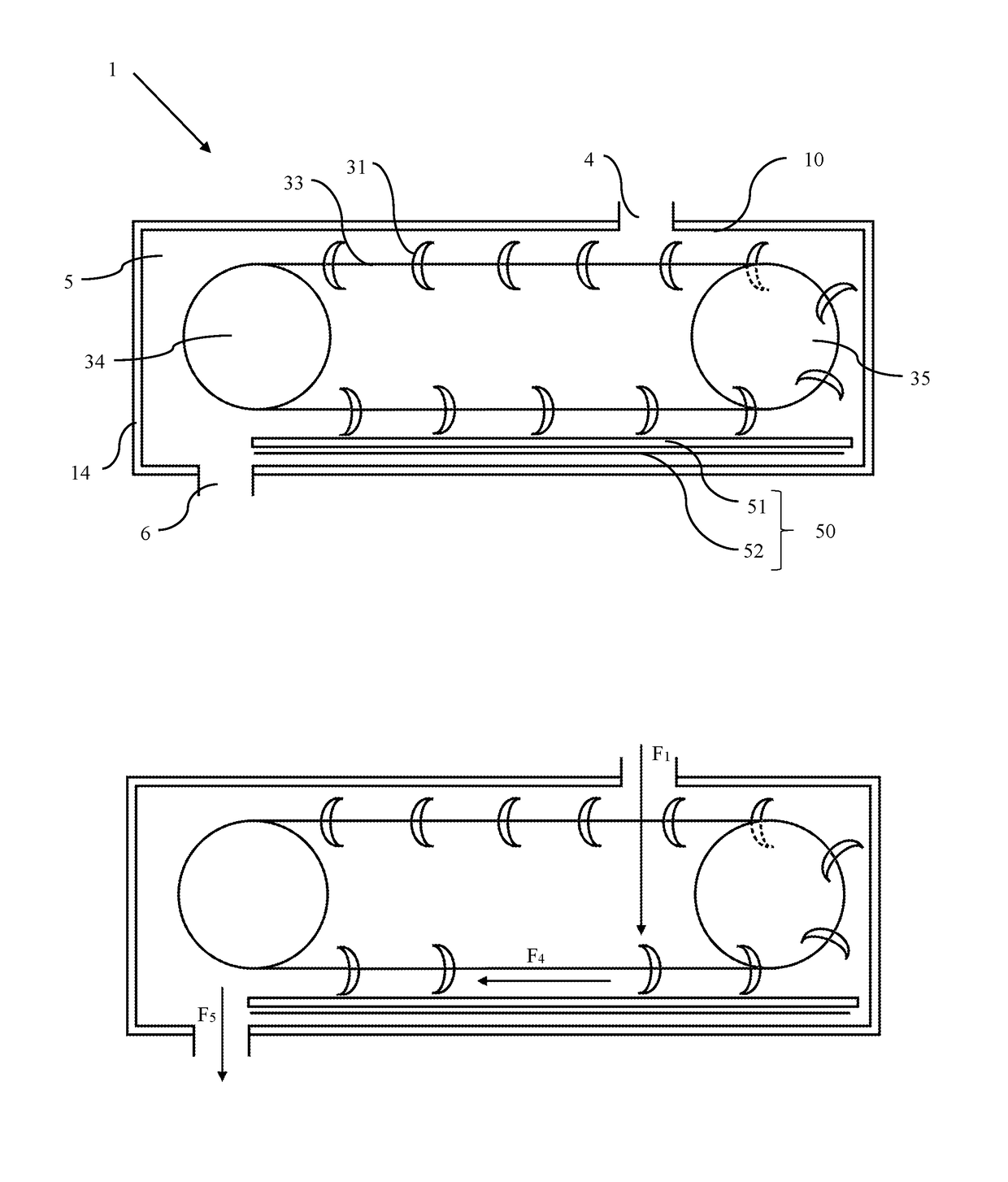System and method for recycling asphalt using induction heating
a technology of induction heating and asphalt, which is applied in the field of system and method for recycling used asphalt materials, can solve the problems of loss of structural integrity, water susceptibility (striping), permanent deformation (rutting), bleeding, shoving and cracking,
- Summary
- Abstract
- Description
- Claims
- Application Information
AI Technical Summary
Benefits of technology
Problems solved by technology
Method used
Image
Examples
example 1
[0058]RAP processor 1 is composed of RAP transfer system 30 and induction heating system 50, as seen in FIG. 1A. RAP transfer system 30 and induction heating system 50 are enclosed in heating chamber 5, which comprises chamber wall 10, and has input 4 for accepting asphalt cement at one end of the RAP processor and output 5 for releasing heated asphaltic concrete from RAP processor 1 opposite input 4. Wall insulation 14 is formed of Fiberfax® alumina-silica insulation and disposed on wall 10 to limit heat transfer and escape from RAP processor 1. RAP transfer system 30 is composed of chain sprocket set 34 and ancillary chain sprocket set 35, which are rotatably mounted to chamber wall 10 or a frame in RAP processor 1. One chain sprocket set, such as chain sprocket set 34 is in mechanical communication with a drive system. Without limiting the scope of the invention, as an example chain sprocket set 34 is attached to a drive shaft that extends through chamber wall 10. The drive shaft...
example 2
[0061]RAP transfer system 30 can vary based on the desired characteristics of the system. The RAP transfer system is formed of two sprockets sets on either side of the RAP processor, i.e. first chain sprocket set 34a and second chain sprocket set 34b on one end of the RAP processor and first ancillary chain sprocket set 35a and first ancillary chain sprocket set 35b on the opposite end of the RAP processor. The distance between first chain sprocket set 34a and second chain sprocket set 34b or first ancillary chain sprocket set 35b is sufficient to permit paddle 31 to pass between the sprocket set. This allows paddle 31 to be attached to paddle chain 33 in various configurations. For example, paddle 31 can have attaching points on the lower edge of the paddle, as seen in FIG. 2A, or at the middle of the paddle, as seen in FIG. 2B. Paddle chain 33 is formed of a plurality of sections, 33a, 33b, 33c, 33d, etc., with each paddle attached to a single section of chain. Paddle 31 further c...
example 3
[0063]RAP processor 1 optionally includes at least one convection system 70, seen in FIG. 4. The at least one convection system works to blow heat towards the used asphalt cement (RAP), providing convectional heat, which heats asphalt not directly contacting the induction plate, as well as allowing asphaltic concrete to retain heat as it leaves the induction plate. Convection system 70 consists of blower 71, with convection system input 72 attached to the blower input and convection blower output 73 disposed on the blower output.
[0064]Convection system input 72 can be a duct allowing air to collect from the interior lumen of RAP processor 1. Alternatively, convection system input 72 can comprise a duct transferring air from the interior of RAP processor 1 to a water condenser. The water condenser can be any system allowing water to separate from ambient air, such as an enclosed space disposed separately from the interior of the RAP processor.
[0065]Convection blower output 73 include...
PUM
| Property | Measurement | Unit |
|---|---|---|
| Temperature | aaaaa | aaaaa |
| Temperature | aaaaa | aaaaa |
| Magnetic field | aaaaa | aaaaa |
Abstract
Description
Claims
Application Information
 Login to View More
Login to View More - R&D
- Intellectual Property
- Life Sciences
- Materials
- Tech Scout
- Unparalleled Data Quality
- Higher Quality Content
- 60% Fewer Hallucinations
Browse by: Latest US Patents, China's latest patents, Technical Efficacy Thesaurus, Application Domain, Technology Topic, Popular Technical Reports.
© 2025 PatSnap. All rights reserved.Legal|Privacy policy|Modern Slavery Act Transparency Statement|Sitemap|About US| Contact US: help@patsnap.com



